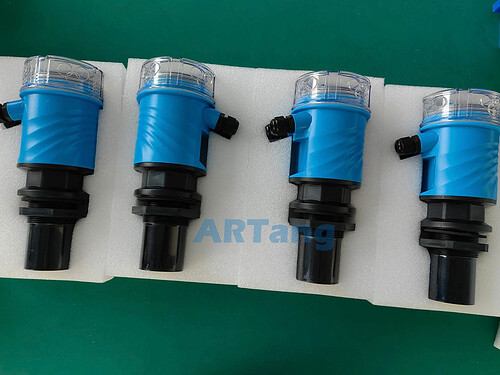An ultrasonic liquid level transmitter—also known as an ultrasonic level meter—is a non-contact, highly reliable, cost-effective, and easy-to-install liquid level measurement device. It can meet most level-measurement requirements without contacting the medium. It can measure liquids, solids, and powders, making it an ideal choice for highly corrosive liquids, coating materials, and wastewater. Because ultrasonic level transmitters do not need to contact the medium, support continuous measurement, and have low operating costs, they are widely favored by users.
Working Principle of an Ultrasonic Liquid Level Transmitter
Its operation is based on the principles of ultrasonic wave propagation and echo reflection. The sensor mainly consists of a transmitter and a receiver. During operation, the transmitter emits ultrasonic pulses, which travel through the medium (such as air or liquid) to the surface of the target (such as a liquid level) and are reflected back. The receiver then detects the returning ultrasonic signal and converts it into an electrical signal. By accurately measuring the time it takes for the ultrasonic pulse to travel from emission to reflection and back to reception—and combining that with the known speed of sound—the distance between the sensor and the target can be calculated, allowing the system to determine the liquid level height. What Are the Advantages and Disadvantages of an Ultrasonic Liquid Level Transmitter? Advantages of an Ultrasonic Liquid Level Transmitter High Accuracy: Compared with traditional contact-type level sensors, ultrasonic level transmitters can detect smaller liquid volumes and provide higher measurement accuracy, meeting applications that require precise level monitoring. High Reliability: They use non-destructive, non-contact technology that does not damage the system and can detect tiny bubbles and impurities in the liquid, ensuring accurate and reliable level measurements. High Sensitivity: Ultrasonic sensors can detect very small fluctuations in liquid level, ensuring accurate monitoring even when the liquid is in motion. Easy Maintenance: With no mechanical parts, the transmitter is easy to repair, replace, calibrate, and adjust. Non-Contact Measurement: Since it does not need to touch the medium, it avoids wear, contamination, and safety risks—making it particularly suitable for corrosive, high-temperature, high-pressure, or viscous liquids. Disadvantages of an Ultrasonic Liquid Level Transmitter Blind Zone Limitation: Ultrasonic level transmitters have a “dead zone,” an area near the transducer where the instrument cannot receive the echo signal. Shorter measuring ranges → smaller blind zones Longer measuring ranges → larger blind zones They are also sensitive to temperature changes because temperature variations affect the speed of sound, resulting in measurement errors. No Obstacles Allowed Beneath the Transducer: Since ultrasonic transmitters rely on reflected sound waves, any obstruction under the probe will interfere with the echo signal and affect measurement accuracy. Not Suitable for Pressure Vessels: High pressure affects the sensor’s performance. Pressure changes influence temperature, which in turn changes the speed of sound, reducing measurement accuracy. Not Suitable for Media with Heavy Foam, Vapor, or Water Mist: These conditions absorb or scatter sound waves, causing weak or lost signals and significantly lowering accuracy. Susceptible to Dust: Although dust has little impact on sound velocity, it causes strong attenuation of ultrasonic waves. Therefore, ultrasonic level transmitters should not be used in dusty environments.
Applications of Ultrasonic Liquid Level Transmitters
Industrial Sector: Used in chemical, petroleum, pharmaceutical, and other industries to monitor liquid levels in storage tanks, reactors, and similar equipment, ensuring production safety and improving operational efficiency. Environmental Protection: Applied in water treatment and wastewater treatment processes to monitor level changes in basins, water towers, and waterways, helping adjust process parameters and prevent environmental pollution. Energy Industry: Used in oil tanks, gas tanks, and other storage facilities to accurately measure liquid levels, providing critical data for energy dispatching and inventory management. Smart Home Systems: Installed in smart water tanks, smart bathtubs, and similar devices to monitor water levels, enhancing convenience and comfort in daily life. Agricultural Irrigation: Used to monitor water level changes in irrigation ponds, enabling precise and water-efficient irrigation.
Installation Considerations for an Ultrasonic Liquid Level Transmitter
Avoid interference: The installation location should be away from inlets/outlets, mixers, obstacles, and other elements that may cause signal interference. Representative installation: The transmitter should be installed at a location that accurately reflects the actual liquid level of the measured medium. Vertical installation: The sensor must be mounted perpendicular to the liquid surface to ensure the ultrasonic signal can properly reflect and be received. Distance control: The distance between the sensor and the liquid surface should be appropriate—not too close to avoid errors caused by liquid fluctuations, and not too far to ensure reliable signal reflection. Environmental adaptability: Consider environmental factors such as temperature, humidity, and corrosive gases, and take proper protective measures. Safety compliance: In hazardous or explosive environments, an explosion-proof ultrasonic level transmitter must be used and installed strictly according to safety and explosion-proof requirements. Regular maintenance: After installation, perform initial commissioning and regularly calibrate, inspect, and maintain the transmitter to ensure optimal performance. An ultrasonic liquid level transmitter is a digital level measurement device. It calculates the distance from the sensor to the liquid surface by measuring the time between the emitted and reflected sound waves. Because it uses non-contact measurement, the type of medium is almost unrestricted. It is widely used for level measurement in atmospheric storage tanks, process tanks, small tanks and containers, pump lift stations, wastewater tanks, and various other liquid and solid materials.
